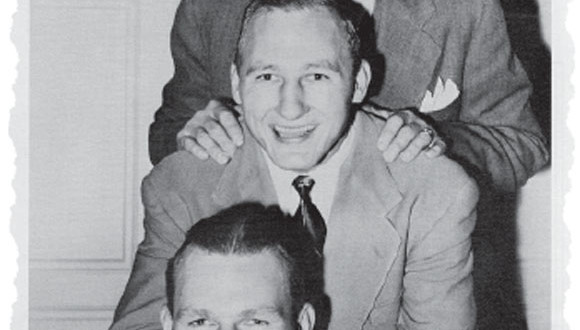by Tom Gregg (Grigonis)

Three Lithuanian American brothers each played football well enough to be inducted into the College Football Hall of Fame. That’s a unique accomplishment, and maybe the heart of our story. But even taking a wider view, the saga of the eight member Wistert family is extraordinary.
FOR THE END OF THE BEGINNING, THIRTEEN- year-old Albert Wistert was sitting by himself in one of the better seats in the Chicago Cubs ballpark for a game late in 1934. He was watching his hero and older brother Francis—long and better known as Whitey—pitch for the visiting Cincinnati Reds in his first major league start. Like Albert, many of his fellow spectators followed other sports closely; they knew that his 22- year-old brother had also been an All American football player for powerhouse Michigan a year earlier. And even the casual fans would know Whitey had pitched well enough to win after watching the last place Reds lose to the superior Cubs 1-0. But nobody could have known then that Whitey, successful in football and seemingly on his way in baseball, would never return to any top level competition after that game.
This was hardly a disaster for the Wisterts. Having one relation who’s made All American or the major leagues is usually one more than anybody else in the neighborhood, so Whitey in his dual sports doings had bestowed something like peripheral prestige on Albert and middle brother Alvin, both of whom were Chicago-born and raised like himself. But in the typical sports family success story when the Whitey character retires with the family honor secure, the top competition aspect ends. With both Albert and Alvin going on to become every bit as fabulous at football as Whitey, the Wisterts in contrast were just getting started.
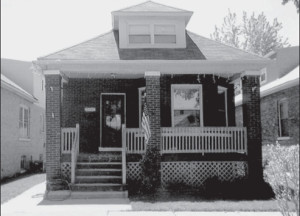
Each of them would arrive at Michigan notoriety via an uncommon if not bizarre route, and in many ways their father Kazimer (Kazimieras) Vistartas seems to have set the tone. Like many first wave Lithuanian immigrants, he had settled in Chicago’s heavily Lithuanian Bridgeport area after arriving in the summer 1895 at age of eighteen. Immigration records list his trade as laborer, which could, and probably did, have the Žagarė native doing anything and everything before he joined the Army during the Spanish American War. Veteran status helped him land a Chicago Police patrolman’s job in 1906 after his return. Kazimer also married fellow immigrant Josephine Šukytė around this time. He and she, nine years his junior, would produce Josephine, Isabelle, Francis, Evelyn, and Alvin at neat two year intervals starting in 1908, and finally Albert in 1920. The latter two survive as this is written.
The parents moved into a new home on the city’s far northwest side in 1915, and here the portrait of a strong individualistic father begins to emerge. Family lore has it that the move to the non-Lithuanian area was prompted by the father’s desire not to hobble his children’s Americanization by overexposure to their countrymen in south side Bridgeport. If that’s true, it was an unusual measure. Around the house in any case, Alvin remembers Kazimer as a doit-all guy, serving as family barber and shoemaker, and erecting a barn out back in which to keep cows and chickens. Albert recalls the father—on mounted patrol for a spell—coming clip-clop down the block on his horse to stop in for lunch on duty days. Giving free rides made Kazimer popular with the neighborhood kids, putting him years ahead of the Officer Friendly program. And as a physical fitness enthusiast who neither smoked nor drank, he was well ahead of his time too.
Judging from the accounts of Alvin and Albert, the family was as close-knit as it was singular. In 1926, however, it would suffer a rent from which it would never fully recover. Chicago police duty in the 1919–1933 Prohibition period was ten times as hazardous as today, and Kazimer lost a gun battle with a serial robbery suspect while on night watch in July. To weather the immediate crisis, fellow officers mobilized during the breakfast hours to donate blood to replace all he’d lost from a serious neck wound. But that was about the only good that would come of the incident. Police never caught the assailant. And surgeons, concerned about blood poisoning, never did find the lodged bullet in five operations across the next eleven months. The death certificate of June 1927 gives the official cause as tuberculosis, almost surely a complication arising from the shooting. Both illnesses can come with unpleasant symptoms, but if Kazimer ever felt any of these, the children never heard. Just as quietly, his badge resides today in a memorial display at Chicago Police Headquarters.
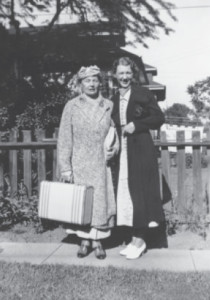
Daughter Josephine quit college and found work after the father’s death, but on the whole life went on as it had been, kind of. The younger boys at six and ten might have missed Kazimer’s guiding hand more than their fifteen year old brother; neither would be the student Whitey was. On the other hand, Whitey would continue spending all his time away from studies at Schurz High on the playing fields, so it was obvious where his passions lay. Still, for all that effort he had an undistinguished sports career for the Bulldogs, and only chance sent him to Michigan. Tagging along with an All State football classmate on a recruiting visit to Ann Arbor in late spring 1930, Whitey was impressed enough to enroll. Admiring his 6’4” 210- pound frame that fall, athletes needled him into going out for football. And whether it was the water, good coaching, or simply a maturation process, he was a starter as a sophomore tackle and a dominant member of the ‘32 and ‘33 National Champion teams. Baseball was the same: WHAM. The converted high school catcher was named Big Ten conference player of the year as a senior.
He opted for the more financially stable pro baseball after graduating in 1934. As we’ve noted, his major league days both came and went quickly, for reasons unclear. Albert, who visited with Whitey and his wife in Nashville after his brother’s demotion in 1935, thinks his arm might not have been all it once was after the Reds had tinkered with his pitching mechanics. That would be consistent with Whitey being shunted to another position in a pinch at Nashville; major league pitching prospects generally aren’t moved so freely. At any rate, with the help and encouragement of his father-in-law lawyer he returned to Michigan and entered law school in 1936, ultimately becoming a labor relations vice president for a Fortune 500 company in Toledo. He served on a naval aircraft carrier during World War II, getting a jolt when a Kamikaze hit the ship during the Okinawa campaign. The family received a similar shock when he died of a heart attack returning from a Florida vacation in 1985.
Whitey coached the ‘39 Wolverine freshman football team during graduate school, and here his path converged again with Albert’s. As with the other brothers, Al’s college arrival was unheralded. Redrawn Chicago school district lines had sent the youngest boy to Foreman HS, which didn’t compete in football. He filled the void playing baseball and basketball, but they didn’t really match his skill set. And to complete the lukewarm athletic prospectus, as the smallest of the three brothers then at 6’0” 205 pounds he wasn’t particularly big for the grid game either. But once he tried out for football and Whitey had schooled him in the lineman’s basics, people began noticing his exceptional quickness, strength, and toughness. He would start all but one game at tackle for his three varsity years. All American honors would roll in for him as a senior, as they had for Whitey. The team, for its part, would be top ten ranked all three seasons but never national champ; Albert would compensate for the omission later.
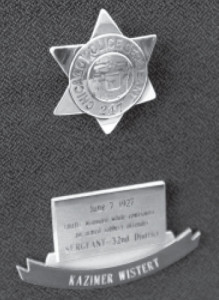
He headed for the National Football League after graduation in 1943, a wrist problem precluding military service. Discussion of the NFL’s sorry wartime state seldom goes far without word of his 1943 Philadelphia Eagles club, which was actually merged with the similarly depleted Pittsburgh Steelers for the one season. There was no question he could handle competition reflective of THAT kind of setup, and he made All Pro 1943 through 1945. Most skeptics of the achievement would be satisfied by a continued All Pro run 1946 through 1950 after the heavy hitters returned from service. Team-wise, Al and several other Hall of Fame grade players led the Eagles to consecutive world championships in 1949 and 1950.
Following his athletic retirement in late 1951, he turned full time to building up an insurance business, one in Philadelphia and another later in California. Having retired to Oregon and against all odds for a nine year veteran of the pro-football wars, at age 82 he continues to indulge a love for the outdoors with horseback riding, running, and bicycling.
Arriving at Michigan in 1947, Alvin was last in order of dramatic appearance, and of the three appearances his was definitely the most dramatic. For starters, he was twelve years behind schedule. The 6’3” 225-pounder might have been the family’s most promising athlete at age eighteen, having once struck out future major league star Phil Cavarretta three times in a high school game. But Alvin was also certainly the least comfortable of the boys in class. Thus, his original college plan of spring 1934 had him attending an Ann Arbor high school and improving on three years of Schurz grades in order to enter the university. A month before graduation as a Michigan prep in 1935, however, he quit. He had been convinced by Michigan’s baseball coach—who had worked him out and of course was totally familiar with Whitey’s abilities— that he had even greater pitching potential than the elder brother. Al didn’t need much convincing; school was a trial, and his foremost ambition had been to play pro baseball. But any prospect quickly died when he suffered a career ending elbow injury in 1936.
Baseball hopes gone and his college preparations self-destructed, he went to work in sales in the years preceding the War. Albert meantime started prospering at Michigan, and it didn’t ease the frustration and regret that with the name similarity he was frequently mistaken for his younger brother. The last straw came after Alvin had joined the Marines. On his Pacific theatre-bound troop ship, an officer greeted him with a warm handshake, thinking that this was Albert. When Alvin pointed out the error, the officer dropped his hand like a shot and bustled off. More lighthearted Albert might have smiled in Alvin’s place; Alvin, a man of pride and dignity, was appalled. “I love you both and I’m proud of what you’ve done,” he wrote Albert that night, “but when I get home I’m going to make something of myself too”. Which to him involved college and football at Michigan.
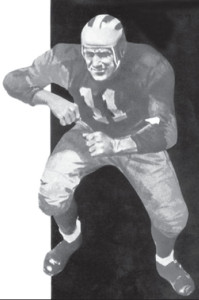
For an unproven scholar on a ten year athletic leave, Alvin’s dream seemed unrealistic, but he pulled it off in Wistert style. He enrolled under the GI Bill of Rights at less selective Boston University in 1946, where the best grades of his life earned a transfer to Ann Arbor after one semester. Displaying rare mobility on the field as the family’s third tackle, he would immediately become an integral part of two national champion teams in 1947 and 1948. Most of his fellow war veterans were gone by 1949 and with Alvin playing through a leg injury the team slipped in the rankings, but he repeated as an All American. That brought the family count on national championships and All American team appointments to four and four.
Declining college coaching and pro playing offers following graduation (college football’s oldest player ever was nearly 34), he returned to sales work in the Ann Arbor area. Long retired and aged 87 this year, he is fully recovered from a 2001 heart surgery and relaxes by gardening around his home and fishing near a lake cottage in northern Michigan. Relaxing pursuits made more relaxing, no doubt, by the fact that he’d finally made his athletic and academic points.
When most star athletes retire, the public recognition stops although the pride they take in their feats does not. They feel a loss, and for a competitive former athlete any loss hurts. The Wisterts had been good enough at least to have received numerous post career tributes, albeit well spaced. These have ranged from casual to extravagant. Alvin once received a letter advising him he’d been inducted into the Schurz Athletics Hall of Fame, but heard nothing further. Nor was anything notable done in the early fifties on Michigan’s retirement of the jersey number 11 that all three Wisterts had worn. The school would atone with a banquet on the trio’s election to the Wolverine Athletic Hall of Fame in 1981. Albert was given a new car among other presentable gifts as the Eagles retired his jersey number 70 in a game day presentation at the end of his final year in Philadelphia. Whitey, Albert, and Alvin were inducted into the College Football Hall of Fame in 1967, 1968, and 1981 respectively, each New York City ceremony being attended by many family members. Albert, who has been judged by some to be the best player not yet inducted into the Pro Football Hall of Fame, also has hopes of gaining entry into that shrine.
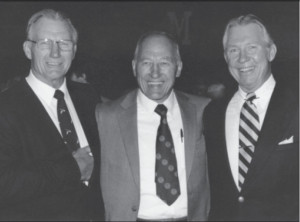
Possibly because it took longer for everything to break for him, Alvin of the two Als seems to hold the greater appreciation of the significance of his family’s three College Hall elections. He’s quick to point out, as others have in print, that to date there’s never been anything like it in the history of college football. One thinks of a line from a countrified and quotable pro football coach of the 1980s. Speaking of his best player he said, “he may not be in a class by himself, but whatever class he’s in it doesn’t take long to call roll.” The same goes for the Wisterts. Class dismissed.
 DRAUGAS NEWS Lithuanian World Wide News in English
DRAUGAS NEWS Lithuanian World Wide News in English
